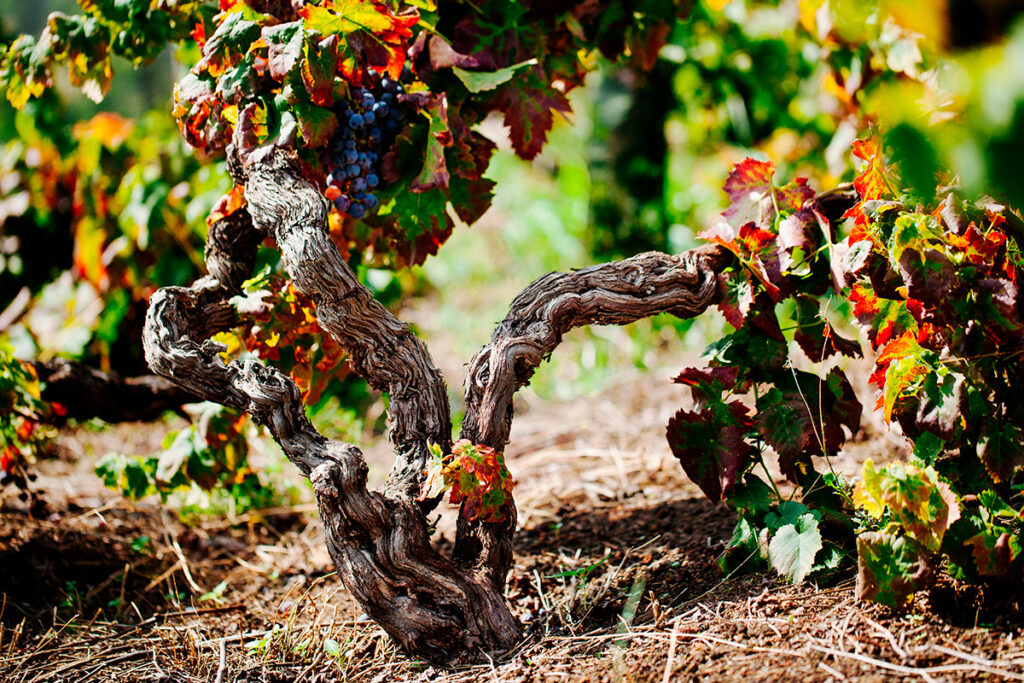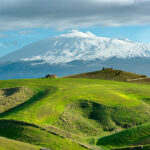A wine with an international success that was born overlooking the sea from the terraces created on the sides of the volcano
Etna, as we could see in the article on its Natural Park, is not only lava and ash but also a great source of life. From the large summit lava deserts we move on to areas where nature dominates unchallenged. In Zone B, which descends from 1880 meters to 640 meters above sea level, agriculture has developed, with terraces created on the sides of the volcano that also host important vineyards. The prince of the vines on Etna is Nerello Mascalese or, in Sicilian, “Niuriddu Mascalisi”.
The name “mascalese” derives from the area of origin, that of the Piana di Mascali, which is located on the eastern side of Etna, between the sea and the volcano, while “nerello” is due to the dark and intense color of its grapes. Today the cultivation of Nerello Mascalese is present throughout the surrounding area, although its territory of excellence is the one found between the municipalities of Castiglione di Sicilia and Randazzo. The most prestigious version of the wine was born on the volcano, the one under the Etna DOC denomination.
It is not easy to trace the origins of Nerello Mascalese: the first appearances of this native vine date back to the time of the ancient Greeks, initially in Calabria and then, around 700 BC, in the area of Catania. The Greeks linked its cultivation to the worship of the god of wine, Dionysius. In Roman times, however, it reached its full diffusion on the slopes of the volcano, in the Mascali Plain that would give it its name. Over the centuries, even after the fall of the Roman Empire and the succession of dominations, production has never stopped. The vines (that is, those grown in areas that are inaccessible due to climate, soil, slopes or extreme altitudes) of the Nerello Mascalese grown on Etna have also resisted the phylloxera epidemic of the late 1800s (the insect had destroyed, in 1895, 96,246 hectares of land throughout Sicily). But it is only in the 20th century that important results were obtained, enhancing the quality of the native vine which, in the new millennium, has become one of the most appreciated at a national and international level.
Nerello Mascalese is used today for both monovarietal winemaking and in blends with other grape varieties. Since 1968 it has become the basis for the DOC denomination of Etna Rosso, of which it represents 80% (the remaining 20% is given by the Nerello Cappuccio vines). The vine is also grown in the extreme tip of the province of Messina, in Faro, as well as in Sambuca di Sicilia, Marsala, Alcamo and in the County of Sclafani: it is no coincidence that it is the second most cultivated vine in Sicily after Nero d’Avola. Nerello Mascalese is therefore present to a lesser extent in the DOC of Faro (where it must be present between 45 and 60% together with Nerello Cappuccio, between 15 and 30%, and Nocera, between 5 and 10%), Alcamo, Sclafani County, Marsala and Sambuca di Sicilia.

The Nerello Mascalese cultivated on Etna has unique characteristics due to the conformation of the soil: the volcanic soils have a basaltic texture and a presence of allophane clays which produce good thermal conduction. The vine has been made strong and resistant by the high altitude, given that it is cultivated up to 1100 meters above sea level, and by the practice of offshoot breeding, which consists of burying a vine shoot to obtain the multiplication by propagation of the plant, cutting the branch from the mother plant once it has developed its roots; it is characterized by a set of heterogeneous clonal plants that are vigorous from the point of view of production and vegetation, which have a large, predominantly pentagonal leaf, while the bunch is large and elongated, conical in shape. The berries have a characteristic oblong shape and are light blue in color. The vine also has a late maturation and the harvest is usually done between the second and third week of October.
Nerello Mascalese, vinified in purity, has a ruby red color, tending towards garnet. On the palate it is dry, harmonious and persistent. When it is vinified in the absence of pomace, it is known as “Pesta in Botte”, and has a deep red color, with a full, warm and dry taste. The alcohol content is high, between 13 and 14 degrees. In the one cultivated in volcanic soils, it is possible to perceive a strong minerality.
It is served at a temperature between 17 and 18 degrees and is excellent both as an aperitif wine, to accompany cured meats and mature cheeses, and for first courses seasoned with meat sauces, and for second courses based on red meat.
Nerello Mascalese is one of the most important wines produced in Sicily but also one of the most complex to manage: the vines are subject to a high variability that can compromise them, due to the sandy nature of the volcanic soil which creates water stress due to abundant rainfall of the period preceding the summer, to the summer heat which, on the contrary, creates drought strain. For this reason, winegrowers constantly work on clonal enhancement and selective program that allows the vines to be increasingly resistant.
Nerello Mascalese, like other noble vines, remains a vine with a notable sensitivity to the vintage and the territory of origin. It is one of the oldest native crops in Sicily and also one of the most difficult, especially for those grown on Etna. The result, however, is well worth the production effort: the elegance of the wine, its authentic flavor and its quality make it unique and appreciated throughout the world.





Comments are closed.